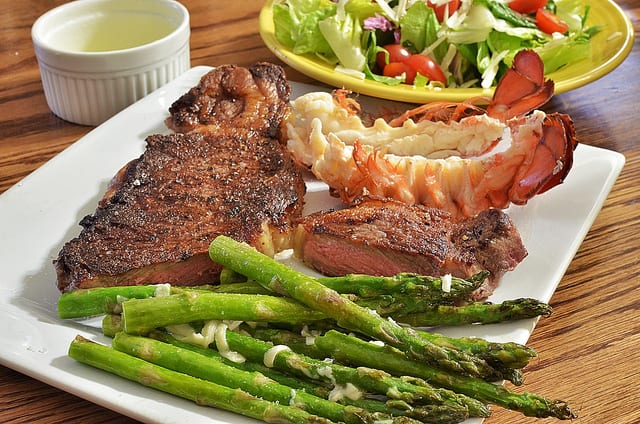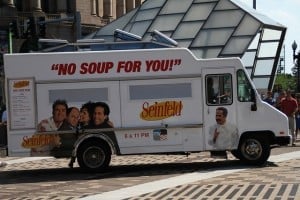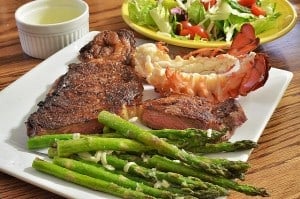Seinfeld, once the anchor of NBC’s “Must-See TV,” gave us many memorable characters, including the so-called “Soup Nazi.” A temperamental restaurateur sells soup that is praised wide and far. However, he is very particular about how his customers must behave. Only the worthy get soup, the rest are dismissed with a curt “No soup for you!”
Apparently the Soup Nazi is the role model for a new strain of legislative misbehavior. Missouri Republican Rick Brattin wants to ban poor people from eating steak and seafood, as well as energy drinks, cookies, chips, and soft drinks. That’s not hyperbole. The language is taken straight from the bill he has introduced to the Missouri State Legislature. Thankfully, though, he won’t ban coffee. So, hey, at least we know that the working poor will be caffeinated enough to get through their hectic and irrational work days.
To be clear, the bill would not tell stores to refuse service to poor people. Rather, it would eliminate what sorts of foods those on the Supplemental Nutrition Assistance Program (SNAP) would be eligible for purchase. SNAP, more commonly referred to as “food stamps,” is a federal program to ensure that everyone in the United States has sufficient and nutritious food. Although a federally-funded program, it is administered by the individual states. Thus, each state is able to set certain requirements over and above the federally-mandated income rules, and each state has leeway to limit how the program is used.
Legislators like Mr. Brattin are apparently seriously agitated by the possibility that SNAP recipients are indulging in luxury items, like the aforementioned seafood and steak. They are upset at stories, like this one Fox News ran a few years ago, where someone proudly discusses how getting a job “isn’t for him” and uses “our wonderful tax dollars” for such indulgences as lobster and sushi. It is, in all honesty, a re-hash of Ronald Reagan’s old “welfare queens driving Cadillacs” trope. These stories play on fears and anger that someone is gaming the system and avoiding real work to get big payoffs.
It was a ridiculous charge when Reagan made it. It is a ridiculous charge when Mr. Brattin and his colleagues (and Fox News) make it. And it will be a ridiculous charge the next time someone decides to announce publicly what financially distressed individuals should or should not be allowed to buy.
SNAP is not a set of coupons allowing someone to get what she wants from any old grocery store. One does not simply walk into Whole Foods, hand over your SNAP card and announce, “Oh, I’d like some surf & turf tonight. Give me lobster tail and a juicy porterhouse.” Or, if you did, you’d likely not be eating too much the rest of the month. Because, of course, SNAP, like many forms of public assistance, is incredibly stingy, both in terms of who qualifies and in terms of what benefits are received.
To start off, the federal government already limits what can be purchased with SNAP benefits. Generally speaking, you can only use SNAP benefits to purchase groceries — grains and breads; fruits and vegetables; meats, fish, and poultry; and dairy products. “Junk foods” do qualify as foods (at least legally), and so can be purchased, as can live animals traditionally purchased for human consumption (think the lobsters in the tank at your local fishmonger).
That seems fairly broad, but there are restrictions. Benefits cannot be used to purchase hot meals, vitamins or nutritional supplements, non-food groceries, pet food, beer or wine or other alcohol, or food to be consumed on the premises.1 Also, retailers must be approved to receive SNAP benefits and, of course, must agree to accept them, something they are not required to do.
Beyond these restrictions, the government limits who can receive SNAP benefits and how much an individual receives. The calculations are quite strict.2 Restrictions come in two flavors — income limits and asset limits. Households are limited both in the amount of income coming in, as well as the amount of personal assets — bank accounts, vehicles, etc. — that they can have.3 For example, a single individual can make no more than $1,265 per month; for a family of four, the limit rises to $2,584 (the numbers are slightly different if there are elderly members). To put that in perspective, $1,265 a month is $7.90 per hour, assuming a forty-hour work week over a four-week month. So, if you make just over minimum wage and are full-time, you won’t qualify.
Assuming you do qualify, your benefit is relatively limited.4 An individual with no income gets the monthly maximum of $194. As her income goes up, her benefit will go down. But, even if you get the maximum amount, you haven’t won the grocery jackpot. That $194 works out to just under $7 per day in a 30-day month. At three meals per day, that is just about $2.67 per meal. Hardly luxurious.
Remember our surf & turf eating friend from above? Were he to actually try to eat that on his SNAP benefit, he would find himself scrimping for the rest of the month. At a local Omaha-area Walmart, a relatively inexpensive place to buy groceries, a simple and inexpensive version of surf & turf would run just over $20 dollars, or about a tenth of your total maximum potential allotment for an individual. For one meal. Clearly, no one is getting rich off SNAP (or other government assistance for that matter). So why the fuss?
Mr. Brattin admits it openly to the Washington Post. He thinks poor people should not be spending taxpayer money on what he considers luxurious.
“My intention wasn’t to get rid of canned tuna and fish sticks,” he said. But he also insists that people are abusing the system by purchasing luxury foods, and believes that that must be stopped, even if it ends up requiring the inclusion of other less luxurious items.
“I have seen people purchasing filet mignons and crab legs with their EBT cards,” he said. “When I can’t afford it on my pay, I don’t want people on the taxpayer’s dime to afford those kinds of foods either.”
As you can see, his concern is not with the nutritional values of the food, but with the perception that these people should not have this kind of food. Canned tuna is OK. Ahi tuna, though, is clearly out. Processed fish sticks are acceptable. Fresh fish, not so much.
Nutritionists already are concerned about SNAP benefits and healthy eating. And that might be an interesting discussion to have. The conversation sparked by this kind of legislation, however, is misguided. Worse, it is uncharitable. It reflects an unhealthy attempt to stigmatize, marginalize, and control a population already suffering under heavy stigmas, living on the margins, and heavily controlled by burdensome government regulations and police interactions.
Why should any of us care how a particular family chooses to spend its money or what it chooses to eat? All of our families make choices regarding food that is subject to second-guessing by others. Maybe we splurge on steak because it is our son’s birthday. Maybe we buy a pack of cookie-dough flavored Oreo’s just to have a simple snack at the end of the day. Maybe we just buy whatever’s on sale.
Rules such as the law being proposed in Missouri aren’t about healthy eating. And they are not about preventing fraud or making the system function better. They are about shaming. They are about judging. They allow us to make a moral judgment about a person and tell that person how to behave. At some level, they allow us to punish someone for being poor. Food is an essential human right. And rules like this embarrass people for daring to try to exercise that right with dignity.
If we say we’ll feed someone, but only on our own terms, we are not doing it for them, but for ourselves. It is already difficult enough for someone to get access to sufficient nutrition. There is no need for us to be smug and insufferable about what sorts of nutrition we’ll let them have access to. We don’t need to be latter-day soup nazis.
— // —
For another analysis of this issue over at America, click here.
- Certain elderly and disabled recipients can use SNAP benefits in exchange for hot meals at pre-approved restaurants. The idea behind this is that food is not particularly helpful when someone lacks the means to actually cook it. ↩
- Similar calculations govern most, if not all, programs that form part of the so-called “safety net.” Beyond income limits, certain immigrants or other non-citizens are excluded from these programs. Because, of course, poor immigrants don’t need to eat? ↩
- Such calculations are quite complex. The link above contains the full chart for both assets and income limits. ↩
- The government assumes that a household will spend 30% of its income on food. Thus, a “maximum allotment” is determined based on the income eligibility. The specific applicant has his or her monthly income multiplied by 0.3, that amount is subtracted from the monthly maximum allotment, and the difference is the actual benefit. ↩




